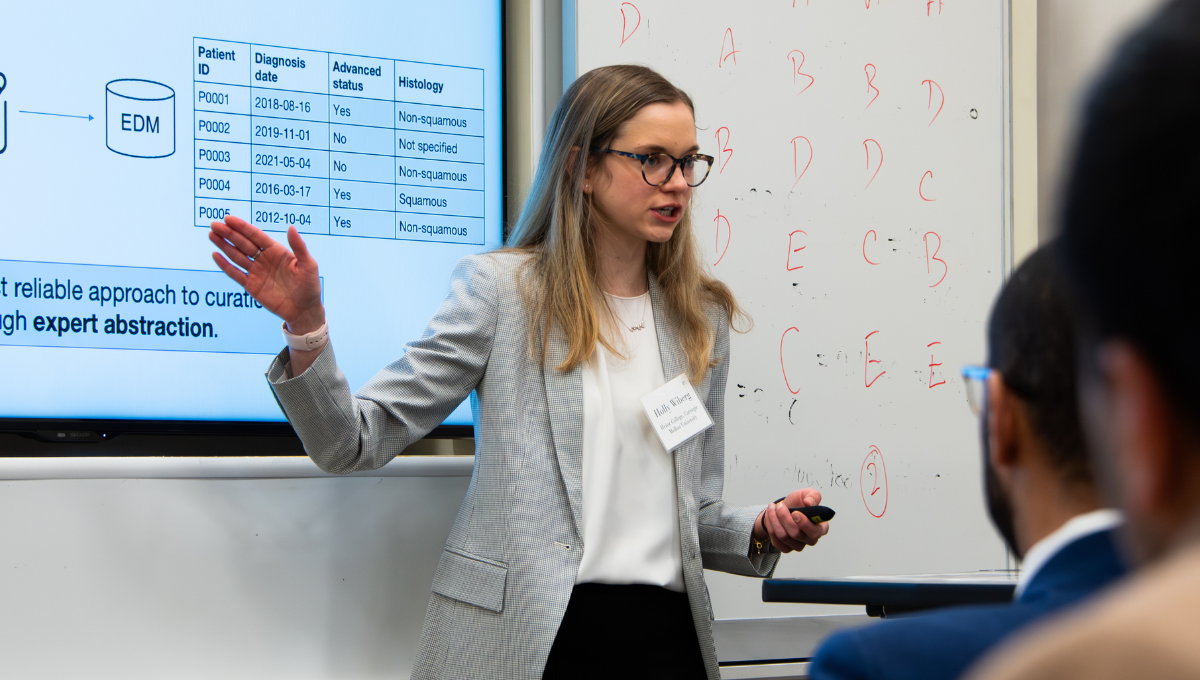I Can Solve It With a Broken Heart: Using Taylor Swift to Teach Management Science
By Bill Brink
One afternoon in April, a few days after Taylor Swift danced with Travis Kelce at Coachella and a few days before she unveiled “The Tortured Poets Department” to the world, a concert setlist had Heinz College students up in arms.
“The one song I remember on it was hoax, from folklore. Not great.”
“We were pretty upset that the vault tracks were excluded. I want to make sure that’s on the record.”
This setlist did not emanate from her marathon Eras Tour concerts. The eight-song order was the result of an assignment in Professor Holly Wiberg’s Management Science class, a twist to spice up the study of policy and optimization and ensure that this lesson hit different.
“I felt more connected to the cohort,” said Kylee Mattson, a student in Wiberg’s class who is now one of her teaching assistants. “It was very much a bonding experience. And it helped us bond with Holly, too, because you could tell she was passionate about it.”
A fan from the very first day
Before Wiberg was a Heinz professor, before she earned her Ph.D. in Operations Research from MIT, she was a Swiftie. She and her sister bonded over Taylor during the Fearless tour, and now as adults living in different cities, they still call each other immediately after each album release to debrief. (At last year’s Institute for Operations Research and the Management Sciences annual conference in Phoenix, the night before a series of 8 a.m. talks and panels, she and six other faculty members went to see the movie version of the Eras Tour, complete with Swift friendship bracelets.)

Management Science in Style
Professor Holly Wiberg wanted a new way to teach optimization that would resonate with her students.
"We were at the perfect age when Taylor started releasing music, with her being just a few years older," Wiberg said. "There’s been a song to capture pretty much every up and down of growing up and figuring out the real world."
While teaching Management Science during her first year at Heinz College, Wiberg searched for an engaging use case for optimization other than the common examples from manufacturing or inventory management—things that, as Wiberg put it, “are definitely important, but not necessarily super relatable or super fun.”
She had another idea.
“I thought, setlist design is a perfect application of the stuff that we do in optimization: we want to ‘cover’ different genres without having to play all songs,” Wiberg said. “There are a lot of interdependencies that we can represent through logical constraints–think: if this happens, then that has to happen. Here we are talking about a concert, but the same idea applies in important policy contexts, like deciding where to place fire stations in a city to cover all neighborhoods in the case of emergencies.”
Problem 4 [26 pts]: Taylor Swift setlist
Taylor Swift is planning a special event where she will play songs from her three re-released albums (Fearless, Speak Now, and Red) along with folklore, her pandemic hit. You are on her tour team and need to make the setlist: you want the shortest set (in terms of duration) that will satisfy all tastes.
“Having a problem like this, it made it seem like management science could be more applicable to different areas of your life that you may not realize,” said Katherine Stancil, another of Wiberg’s TAs.
I felt more connected to the cohort. It was very much a bonding experience. And it helped us bond with Holly, too, because you could tell she was passionate about it.Kylee Mattson | Wiberg's student and TA
The students needed to find the optimal setlist, one that covered similar songs as defined by Spotify’s similarity score. They later had to work through curveballs: exactly one song with a special guest, you can only play Begin Again if you also play Dear John, etc. The end game was one optimized setlist, but it ended with one big problem.
Suboptimal Result
“Bad.”
“Holly, where are the vault tracks?”
“It ended up being a 30-minute set, and we were like, ‘Oh, come on.’”

Mattson, Stancil and Jared McHale, another former student and current TA, spoke for the class when they voiced their displeasure with the “correct” answer: a short setlist with poor selections, which generated a half-hour discussion after recitation one day.
“Heinz is a really amazing cohort of non-traditional academic people,” Mattson said. “And coming from an institution that was predominately white men, which is not what I am, it’s nice to see diversity in who is educating you and their interests, and them attempting to teach you in a way that you really care about. And I think Dr. Wiberg did that.”
Stancil’s mother played Taylor for her as a child, turning her clock radio to the country station back when Swift sang such songs, and like Wiberg she shared her fanhood with her sister. Mattson was 14 when Red came out, and “We Are Never Ever Getting Back Together” hooked her. McHale was late to the game, drawn in when Swift began re-releasing her earlier albums, and “then I just listened to her entire discography. And this is where I’m at in my life.” Pairing the ubiquity of Swift fandom with an optimization lesson led to more engagement than usual, and it’s part of what compelled the trio to become TAs this semester. But for Mattson, Stancil and McHale, three graduating Master of Science in Public Policy and Management students, the professor-TA alchemy has resulted in more than a shared interest in an artist.
“She’s connected me to post-docs here that do the kind of work I’m interested in,” Mattson said. “She has just been a great resource in general. And I think she was made a lot more approachable, because you see ‘MIT-educated doctor,’ and I was like, ‘This person is scary,’ and then she did this assignment.”